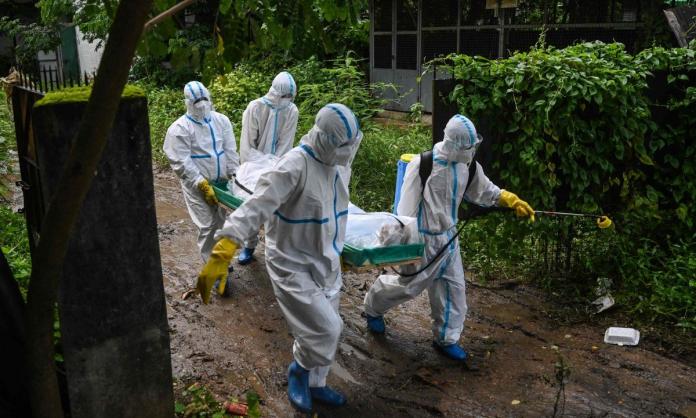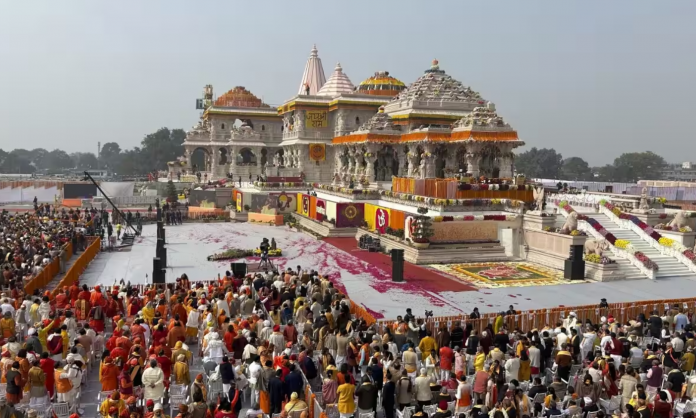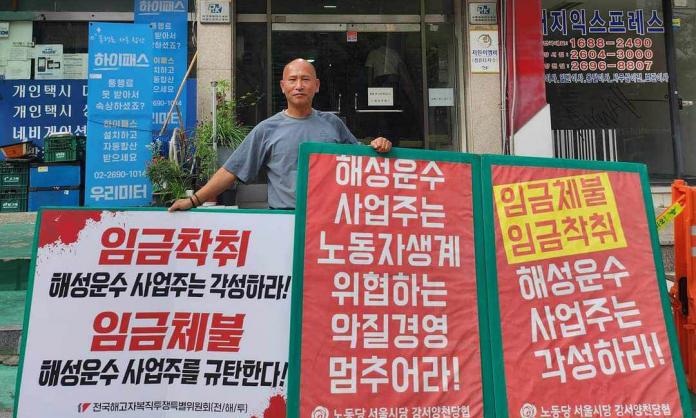Six months after seizing power in a coup, Min Aung Hlaing’s regime in Myanmar is facing a third wave of COVID-19. Beginning in late May, the outbreak has now engulfed 90 percent of cities and towns across the country, as confirmed cases and daily deaths increase.
Despite new cases rising to 122 on 1 June, and the seven-day daily average more than doubling since the Ministry of Health and Sports (MOHS) announced the beginning of a third wave on 25 May, the junta continued with its planned nationwide reopening of schools and universities, which had been closed since last year. (This followed the reopening of large parts of the economy throughout May, including banks, factories, marketplaces, shopping centres, pagodas, beaches and other public venues, as the junta forced striking workers back to work in an attempt to return to “normality”.)
The MOHS reported in mid-June that it had detected three new variants of COVID-19—including the highly infectious Delta strain—in Yangon, in Mandalay, the second largest city, and in north-western Tamu and Kalay, near the Myanmar-India border. By the end of the month, major clusters had emerged in schools, marketplaces and ports; new confirmed cases for the month grew to 13,526, with a seven-day average of 1,050.
“The healthcare system has collapsed; hospitals are either closed or overflowing; people are forced to treat themselves in their homes; the vaccine rollout has ground to a halt; testing is inadequate; health workers are being targeted for arrest; the virus has spread into the prison system; and oxygen is banned from distribution except by authorities under the military’s control”, Me Me Myint,* a former nurse from Yangon Workers’ Hospital, says over the phone from Myanmar. Me Me, who went on strike in February against the coup, is now working in one of the thousands of community-run clinics that have emerged to deal with the health crisis.
Meanwhile, junta leader Min Aung Hlaing appeared on the military-controlled television network MRTV to say that the situation is being exploited by the anti-coup movement to damage the military. “Many people do not trust the junta and refuse to be treated in military-controlled hospitals”, Me Me says. “The junta has tried to use the pandemic to create some legitimacy for their regime by forcing healthcare workers back to work. But many of them, like myself, have arrest warrants out for us, so it’s an obvious trap.”
There’s a stay-at-home order in place, and Me Me says residents in Yangon fly yellow flags from their apartment windows to signal that they need medical supplies. An accompanying white flag signals that they are also in need of food. “There are those that cannot afford to stay at home since they survive on day wages. Others must break the curfews to go out in search for oxygen—sometimes lining up all day—only to find that their loved ones have died while they were out. In some cases, whole families have been found dead in their homes.”
New daily cases officially peaked on 14 July at 7,083, but again rose to 6,701 on 22 July, and are expected to peak again. On 26 July, 396 people died in one day. (The population of Myanmar is 55 million. So 396 deaths, on a per capita basis, puts it slightly above Indonesia’s current daily death toll.) Since the third wave began, there have been more than 155,000 new confirmed cases and over 6,100 deaths, doubling the total number of cases and deaths in the first two waves combined, but these official figures likely understate the crisis. (For example, figures collected by Myanmar-Now.org from three major Yangon-based social support groups in July showed the number of funerals being held has risen from 100 to 600 per day in Yangon alone.)
While the fallout from the February coup has been a major factor in the crisis, James,* a student leader and Marxist, says that other factors are at play. “The vast inequalities that characterise Myanmar—including low wages, high levels of precarious employment, low life expectancy, inadequate health services—are not simply a product of our long history of military rule, but the integration of the country into the global capitalist system, primarily through resource extraction”, he says over the phone.
“Our ‘democratic transition’ was a power-sharing agreement between the military and civilian leaders that still maintained these inequalities. The criminal mismanagement of the pandemic by the junta leaders should not distract from what took place under the previous NLD [National League for Democracy] government—since it has laid the basis for the situation we are now facing.”
From late March to early August last year, during the first wave of COVID-19, Myanmar recorded just 360 cases and six deaths after the NLD government implemented strict lockdown measures that contained the virus. But the shock reduced economic growth from 6.8 percent to 1.7 percent, according to the World Bank. Without any meaningful welfare in the country, the UN reported that 83 percent of households had their incomes slashed by half, while the number of people living below the poverty line was estimated to have increased by 11 percent.
To boost the economy, the NLD government eased restrictions, which resulted in a second wave of the virus in mid-August and overwhelmed Myanmar’s inadequate health infrastructure. By the time of the February coup, there had been 140,145 confirmed cases and 3,131 people had died; and with daily new cases still averaging over 300 on 1 February, the second wave was barely under control.
The explosion of strikes and demonstrations in response to the coup illustrate that the “democratic transition” had also raised the expectations of Myanmar’s working class. “Those most willing to fight the coup, strike to shut down production, even give up their lives on the barricades—they were not doing so because they wanted a simple return to the status quo of military-NLD rule”, James says. He says that the mobilising factor within the working class, in particular the state sector—health workers, teachers, civil servants, rail workers and so on—was not simply the defence of the elected government; it was the opportunities for social and economic development that they, rightly or wrongly, believed the “democratic transition” had presented.
Similarly, for Myanmar’s female-dominated garment workers, who have proved to be some of the most determined fighters against the coup, it has not been simply a defence of the arbitration system and industrial relations laws that legalised trade unions that motivated them to fight; it was their ability to go beyond those laws through breaking them in wildcat strikes and militant organising over the course of a decade.
The failure of the February and March strike wave to topple the junta is still being widely debated. James thinks the determining factor was the absence of a nationwide political leadership that could extend the strike movement into broader sections of the working class, transform the movement into a fight for control over production and promote widespread mutinies within the armed forces.
Instead, the violent repression of the strike wave, combined with the assertion of the NLD-led National Unity Government as the de facto political leadership of the movement, and its accompanying promotion of intervention by regional powers and sanctions on military-controlled businesses, has promoted a sense of dependency “from above” among the working class, and has meant the junta has thus far been able to weather the storm.
Others argue that the Tatmadaw is a military like no other. For example, Bertil Lintner, writing in the Asia Times, argues that a combination of factors have held the Tatmadaw together and ensured that no cracks have opened in the regime: a “dual-function” ideology, which asserts the military should have both a defence function and an active role in economic and social development; powerful economic interests through military-controlled companies; and a fear of retribution for their many crimes, whether previous atrocities in ethnic regions, or the recent ones carried out while crushing the uprising against the coup. But the cracks that have emerged through defections to the anti-coup movement reveal the same class divisions that structure any modern military.
“There is a huge gap in the wealth between the upper and lower ranks of the Tatmadaw”, former military Captain Nyi Thuta, one of several hundred defectors, says over the phone from somewhere in hiding. “Only the top-level officials are associated with the business sector of the military. These officials get the profits from these businesses, while the rank-and-file personnel do not get any share.”
The difference in pay between a private (the lowest rank) and a middle-ranking officer (such as a lieutenant or captain) is reportedly six-fold. And upper ranking officials, such as generals, receive more than 60 times that of the lowest rank and ten times that of a middle-ranking officer. “Although they [the generals] always speak about ‘state-building’, it appears to many of us that they are simply ‘building’ for themselves.”
As in all modern militaries, a hierarchical chain of command binds the rank-and-file soldiers to their commanding officers; breaking it can mean jail time or death. Furthermore, Captain Thuta says that out of 400,000 soldiers, only 20 percent have been deployed to commit violence against civilians. The bulk of the violence has been committed by the military-controlled riot police.
Soldiers and their families also live a tightly controlled existence, residing in military compounds that require permission to leave, resulting in what Captain Thuta describes as a “hostage” situation. “Many soldiers wish to defect”, he explains, referencing the 75 percent of soldiers who reportedly reject the coup. “But they fear for the safety and lives of their families who remain on the military bases. For those that don’t have a family to worry about, they are not prepared to live on the run as defectors presently do. Under this system, the rank-and-file members of the military and their families are suffering as much as the people.” Now, there are widespread reports of COVID-19 infections and fatalities tearing through the Tatmadaw as well.
The COVID-19 outbreak inside the armed forces has the potential to exacerbate further the class divisions inside the Tatmadaw and destabilise further Min Aung Hlaing’s regime. And despite the ebb of the strike movement, the regime continues to face resistance. From late March, thousands of students and workers have sought safety in the ethnic-controlled borderlands, undergone guerrilla training and formed a number of armed groups under the banner of “People’s Defence Forces”. Since then, many have returned to urban areas to carry out attacks on military patrols and posts. According to figures compiled by Myanmar-Now.org, at least 64 military-affiliated officials have been killed during the attacks thus far.
James says that while an armed component will be necessary to overthrow the junta, it must not do so at the expense of substituting itself for the self-activity of Myanmar’s working class. He says that the daily flash-mob demonstrations that continue in major cities and townships across the country, while still small, help maintain morale and active opposition to the junta in the streets. If the situation shifts, they have the potential to galvanise discontent and wider layers of society behind them. “The movement opposed to the junta must find a way to link up concrete demands around the health and economic crisis to the broader goal of toppling the military regime”, he says.
“In the short term, the third wave of COVID-19, combined with the ongoing fear of repression and the ebb of the strike movement, makes this a very difficult task. But the third wave is not only producing death and misery—it is producing widespread anger and a desire for an alternative to barbarism, too. Whether that anger can be transformed into a renewed assault on the junta will depend on our side’s ability to seize those windows of opportunity for mass opposition when they arise again.”
*Names have been changed to protect identities.











